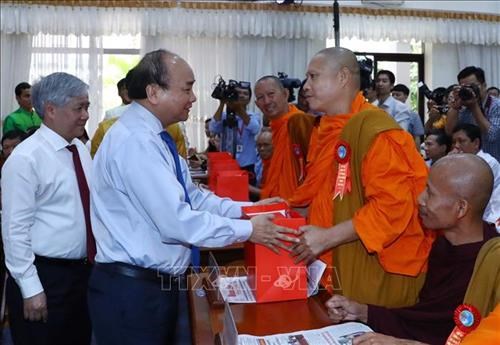Policies aim to better lives of ethnic minority people in Mekong Delta
Thứ Năm, 11/04/2019, 15:20
Around 100 policies and documents related to ethnic minority groups in the Mekong Delta have been implemented to develop essential infrastructure and production, reduce poverty and improve the living standards of local residents.
- Spring festivals promote unique Vietnamese ethnic cultures
- Efforts made to preserve ethnic minority attire
- Vietnamese language teaching enhanced for ethnic children
- Raglai ethnic people’s ceremony recognized as national intangible heritage
- PM presents Tet gifts to disadvantaged ethnic minority people
 |
|
Prime Minister Nguyen Xuan Phuc attends a meeting of outstanding delegates from Khmer ethnic minority group in Can Tho city in April 2019 on the occasion of the traditional Chol Chnam Thmay New Year festival (Photo: VNA) |
According to Hung Thi Somaly, an official from the Government’s Committee for Ethnic Minority Affairs, the rate of poor ethnic minority households in the region reduced significantly to 17.42 percent in 2017 from 23.45 percent in 2016.
Localities in the delta are working toward poverty reduction among ethnic minority groups, including Khmer – which make up 16.5 percent of poor households in the delta.Minister-Chairman of the Committee for Ethnic Minority Affairs Do Van Chien said the rate of households living under the poverty line in the Khmer ethnic group has been decreasing on an average of 3-5 percent per year in recent years.
The State has supported building houses for more than 120,000 Khmer households and land production for nearly 10,000, as well as provided vocational training for 98,000 locals and generated jobs for some 142,000 workers. More than 521,000 households are entitled to preferential loans for production development, he added.
Since 2004, localities in the Mekong Delta have invested in building nearly 230 water supply facilities, supported land production for more than 9,720 households, and offered vocational training for 11,380 workers.
Since 2001, localities have also implemented price subsidy policies for ethnic minority households.
Transport, schools, medical examination facilities, irrigation and electricity systems have also been improved.
VNA

